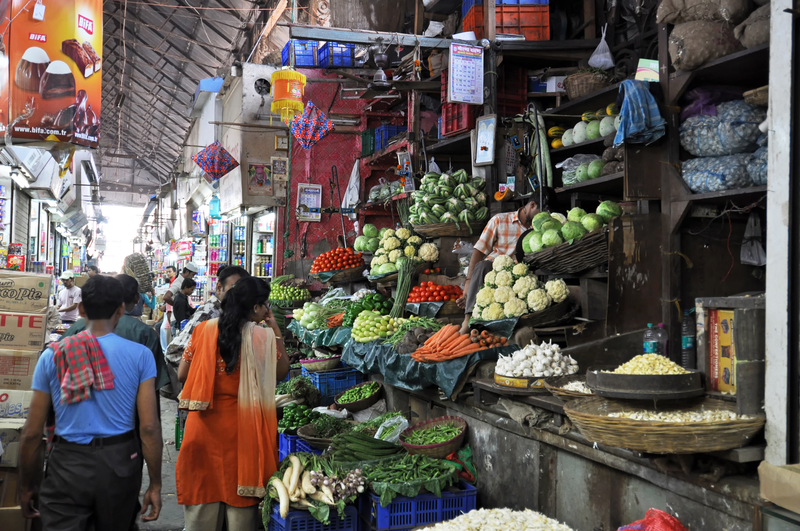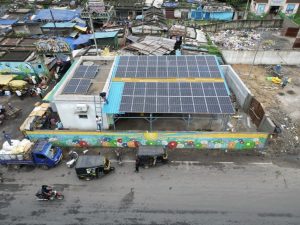
Food markets are a common source of fruits and vegetables for households in India, including the east-coast state of Odisha. Credit: Johnnydevil|Dreamstime.com.
In a region averaging 300 sunny days and 79°F (26°C) annually, selling perishable goods at markets without access to refrigeration is a challenge. But using that sunshine to operate solar-powered coldrooms could help vendors and consumers adapt to a warming climate.
That’s why AAE assistant professor Eleanor Wiseman and colleagues decided to study if freely available coldrooms would improve food supplies and benefit fruit and vegetable vendors in Rourkela, India.
“This project was a perfect fit for my research interests in food security and agricultural markets in low- and middle-income countries,” says Wiseman, a development economist focusing on East Africa and Southeast Asia, who joined AAE in fall 2025 after a postdoctoral fellowship at Stanford University. “We found that free access to coldrooms caused a 20-30% increase in the sales volume and revenue for Rourkela vendors, without affecting consumer prices.”
Rourkela is located in Odisha, one of India’s top vegetable-producing states with high post-harvest losses of 25-40%. This is partially due to sellers traveling long distances in temperatures above 100°F. Wiseman joined the study team after Rourkela had received United Nations and philanthropic funding to set up cold storage facilities in several food markets. These coldrooms and staffed check-in desks were placed at market entry points to be easily recognized by vendors.
In February 2024, the researchers conducted a baseline survey of produce sellers at five of Rourkela’s peri-urban markets. Next, they randomly selected 300 vendors (60 per market) who had consented to participate in the study. The team randomly placed 150 vendors into the “treatment” group that received free coldroom access. The other 150 “control” vendors paid $0.03-0.10 per day for access.
This randomized design ensured that treatment and control groups had similar demographic and vendor features so that the coldroom usage fee was the main difference between them. This allowed the researchers to attribute any differences in sales to the “free access” treatment.
In both groups, about 40% of sellers were women. At baseline, 80% reported losing profits from distress-selling their products at discounted prices at the end of the day to reduce spoilage. One-third of vendors were smallholder farmers growing their own produce. Almost 60% were traders who procured at local village or wholesale markets, and the rest identified as both farmers and traders. Vendors reported their top three crops by revenue, with traders selling 1.8-times higher average volumes than farmers.
The researchers collected satellite-based hourly temperatures and weekly morning and afternoon sales data from May to August 2024. The analysis showed that treated vendors were 66% more likely than control vendors to use coldrooms. This caused a 20-30% increase in sales volume and revenue, without affecting prices. The result was driven by large-scale traders while coldroom availability had little, if any, impact on smallholder farmers, suggesting greater benefits for wealthier people. Earlier studies also reported that socioeconomic status influenced technology adoption.

Only 1-2% of control sellers used coldrooms on any given day. Usage was higher on hotter days when the expected benefit was highest. Treated sellers, on the other hand, had consistently higher take-up rates even on cooler days.
“Treated sellers used the coldroom across the entire temperature distribution, suggesting that access to cold storage helped them become less heat-sensitive,” says Wiseman. “This was consistent with our hypothesis, but less expected was product substitution: We found that more treated than control vendors switched to selling less perishable goods.” Treated vendors, for example, sold more garlic, onions, oranges, apples and other shelf-stable goods than those that quickly spoil without refrigeration, such as mushrooms, ripe bananas and leafy vegetables.
This likely reflects vendors’ beliefs that less perishable goods carry less risk under imperfect storage conditions. The researchers also found that consumers were willing to pay more for “day-of” freshness. Thus, vendors may have faced steeper price discounts when selling highly perishable chilled goods, making it more profitable to store and sell less perishable items instead.
More work is needed to understand the exact reasons for the low usage rates of control vendors during the study period. Since these facilities are new to the region, it may take longer to change deep-rooted habits and establish credibility. Signs at market entry points that highlight the ability of coldrooms to increase vendor revenues might be helpful, notes Wiseman. A comparison of markets with and without coldrooms—by randomizing at the market rather than vendor level—and a longer study period could provide additional insight into usage barriers.
Despite limited explanations for low take-up rates, Wiseman views solar-powered coldrooms as a climate adaptation strategy that is worth exploring further, especially in regions similar to Odisha.
“This is one of the first empirical studies to identify a positive impact of coldrooms in a low-income country across the entire temperature range, which is encouraging,” says Wiseman. “In addition, our finding that large-scale traders gained more than smallholder farmers has important policy implications: Researchers and funding organizations should consider strategies that go beyond financial subsidies to extend these benefits to people living in poverty.”